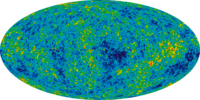
Photo from wikipedia
We introduce an updated physical model to simulate the formation and evolution of galaxies in cosmological, large-scale gravity+magnetohydrodynamical simulations with the moving mesh code AREPO. The overall framework builds upon… Click to show full abstract
We introduce an updated physical model to simulate the formation and evolution of galaxies in cosmological, large-scale gravity+magnetohydrodynamical simulations with the moving mesh code AREPO. The overall framework builds upon the successes of the Illustris galaxy formation model, and includes prescriptions for star formation, stellar evolution, chemical enrichment, primordial and metal-line cooling of the gas, stellar feedback with galactic outflows, and black hole formation, growth and multi-mode feedback. In this paper we give a comprehensive description of the physical and numerical advances which form the core of the IllustrisTNG (The Next Generation) framework. We focus on the revised implementation of the galactic winds, of which we modify the directionality, velocity, thermal content, and energy scalings, and explore its effects on the galaxy population. As described in earlier works, the model also includes a new black hole driven kinetic feedback at low accretion rates, magnetohydrodynamics, and improvements to the numerical scheme. Using a suite of (25 Mpc $h^{-1}$)$^3$ cosmological boxes we assess the outcome of the new model at our fiducial resolution. The presence of a self-consistently amplified magnetic field is shown to have an important impact on the stellar content of $10^{12} M_{\rm sun}$ haloes and above. Finally, we demonstrate that the new galactic winds promise to solve key problems identified in Illustris in matching observational constraints and affecting the stellar content and sizes of the low mass end of the galaxy population.
Journal Title: Monthly Notices of the Royal Astronomical Society
Year Published: 2018
Link to full text (if available)
Share on Social Media: Sign Up to like & get
recommendations!